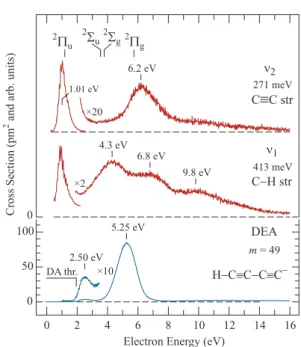Absolute cross sections for electron collisions with diacetylene: Elastic scattering, vibrational
excitation and dissociative attachment
This article has been downloaded from IOPscience. Please scroll down to see the full text article. 2012 J. Phys.: Conf. Ser. 388 052082
(http://iopscience.iop.org/1742-6596/388/5/052082)
Download details:
IP Address: 134.21.47.136
The article was downloaded on 13/12/2012 at 10:56
Please note that terms and conditions apply.
View the table of contents for this issue, or go to the journal homepage for more Home Search Collections Journals About Contact us My IOPscience
Absolute cross sections for electron collisions with diacetylene:
Elastic scattering, vibrational excitation and dissociative attachment
Michael Allan∗1, Olivier May∗, Juraj Fedor∗, Bogdan C. Ib˘anescu∗, Lidija Andri´c†2,
Carl Winstead‡, Vincent McKoy‡3
∗D´epartement de Chimie, Universit´e de Fribourg, 1700 Fribourg, Suisse
†CNRS et Laboratoire de Chimie Physique–Mati`ere et Rayonnement, Universit´e Pierre et Marie Curie, F-75231 Paris Cedex 05, France
‡A. A. Noyes Laboratory of Chemical Physics, California Institute of Technology, Pasadena, California 91125, USA
Synopsis We present absolute experimental cross sections for elastic scattering, vibrational excitation by electron
impact and for dissociative electron attachment to 1,3-butadiyne, as well as calculations of the elastic cross sections.
Electron collisions with diacetylene (1,3-butadiyne, H−C≡C−C≡C−H) are of special in-terest to astronomers due to the recent discov-ery of the H−C≡C−C≡C− anion in interstellar space [1]. We measured absolute cross sections for elastic scattering, vibrational excitation, and for dissociative electron attachment. We also cal-culated differential and integral elastic cross sec-tions in the fixed-nuclei approximation using a parallel implementation of the Schwinger multi-channel method [2]. The calculations employed an extended basis set and included polarization effects.
The measured elastic cross sections show boomerang structure due to the 2Π
u resonance
at 1 eV, and angle-dependent structure due to the 2Πg resonance around 5.5 eV. The essential
features are reproduced by the calculation. The selectivity of vibrational excitation re-veals detailed information about shape reso-nances as shown in Fig. 1. Excitation of the C≡C stretch and of double quanta of the C−H bend vibrations reveal a 2Πu resonance at 1 eV
(au-todetachment width about 30 meV) and a 2Π
g
resonance at 6.2 eV (autodetachment width 1-2 eV). There is a strong preference for excitation of even quanta of the bending vibration. The ex-citation of the odd and even quanta of the bend-ing vibration within the2Πuresonance have very
different angular distributions: the former has a maximum at 90◦, the latter a minimum. Exci-tation of the C−H stretch vibration reveals σ∗ resonances at 4.3, 6.8, and 9.8 eV, with autode-tachment widths of about 2 eV. The detailed in-formation about resonances permits conclusions about mechanism of dissociative electron
attach-ment [3]. 2P u 2Pg 2S u 2S g 0 2 4 6 8 10 12 14 16 0 50 100
Electron Energy (eV)
CrossSection(pm andarb.units) 2 ×10 2.50 eV DA thr. 5.25 eV ×2 413 meV 4.3 eV 6.8 eV 9.8 eV ×20 271 meV 1.01 eV 6.2 eV 0 H- ºC C C C- º -m= 49 DEA C H str -C -C str
º
n1 n2Figure 1. The top two curves show cross sections
for exciting the C≡C and C−H stretch vibrations. Predictions from empirically scaled SCF virtual or-bital energies are indicated by vertical lines and la-bels on the top. The DEA spectrum (loss of H) is shown at the bottom.
References
[1] J. Cernicharo at al 2009 Astronomy and
Astro-physics 467 L37
[2] C. Winstead, V. McKoy 1996 Adv. At., Mol., Opt.
Phys. 36, 183
[3] O. May, J. Fedor, B. C. Ib˘anescu, and M. Allan 2008 Phys. Rev. A 77, 040701(R)
1
E-mail:Michael.Allan@unifr.ch 2 E-mail:Lidija.Andric@upmc.fr 3 E-mail:mckoy@caltech.edu
XXVII International Conference on Photonic, Electronic and Atomic Collisions (ICPEAC 2011) IOP Publishing Journal of Physics: Conference Series 388 (2012) 052082 doi:10.1088/1742-6596/388/5/052082
